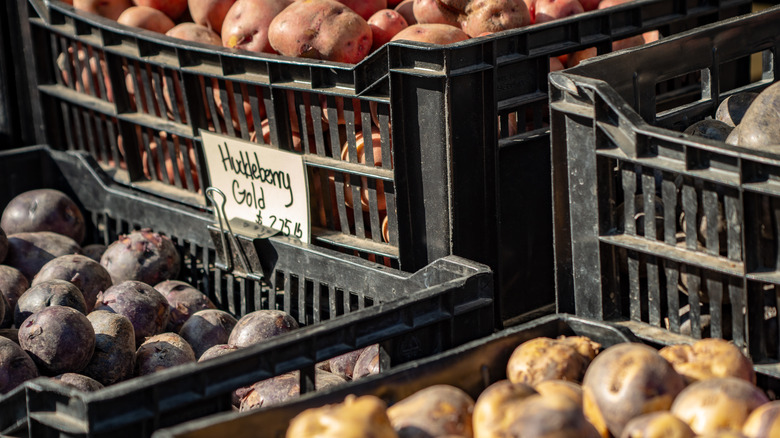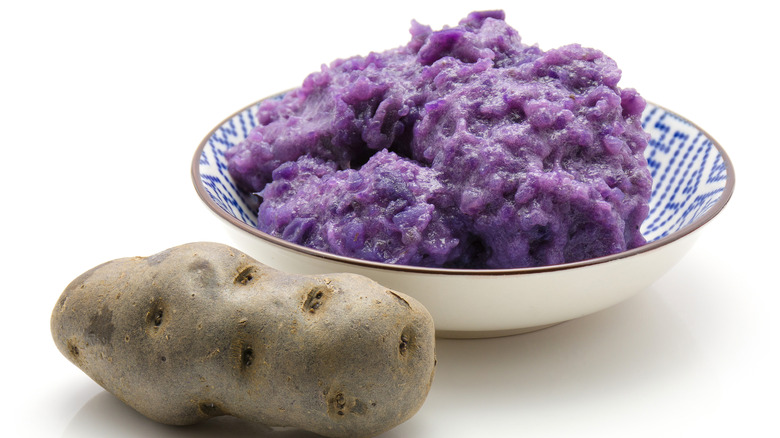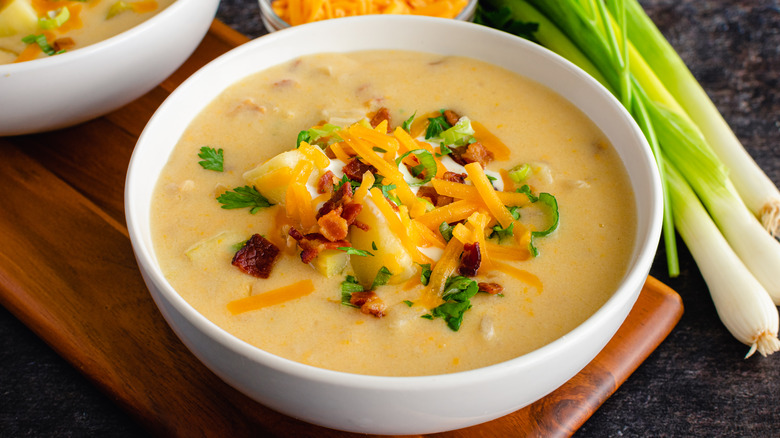Idaho's Huckleberry Gold Potatoes Are Truly One Of A Kind
CORRECTION 10/27/23: A previous version of this article stated these potatoes come from Montana, not Idaho.
Potatoes don't deserve their bad reputation (via The Washington Post). Healthline points out that potatoes contain vitamin C, other vitamins, and antioxidants, and explains that cooking methods like frying in hot oil contribute to their "unhealthy" reputation along with their high amounts of starchy carbohydrates. This gives them a high glycemic index, which Healthline explains is the measure of how much your blood sugar levels increase after eating. But fortunately, through the wonders of plant genetics, the world now has a low-glycemic potato! Look no further than the Huckleberry Gold. It's here to make your potato salad, homefries, gnocchi, and other tot-tastic dishes a little healthier.
Purple potatoes (and berries, cabbage, and other "red" produce) are extra special. Smithsonian Magazine explains that potatoes are originally from the South American Andes Mountains, where they adapted to the elements with high concentrations of dark pigments called anthocyanins that have blood pressure-lowering, disease risk-reducing, and seemingly even cancer-slowing properties (per Cleveland Clinic). But many commercial potato varieties have been bred not with color, but rather other factors in mind. A study on ResearchGate reports that while anthocyanins are present even in familiar red-skinned potatoes, it is the pigmented varieties with the most concentrated levels of these nutrients.
What is a Huckleberry Gold potato?
Seed companies like Renee's Garden describe the Huckleberry Gold as a buttery-tasting potato with rich purple skin and buttery, golden flesh. Agri-View says that the Huckleberry Gold is culinarily similar to the Yukon Gold (a chef favorite), developed by the U.S. Department of Agriculture's Agricultural Research Service in, of course, Idaho. It's also resistant to some common potato diseases, Agri-View adds, which will come in handy when it's trending and in high demand. With growing consumer interest, the ResearchGate-cited study suggests that we might start seeing more potatoes like the Huckleberry Gold at the market that resemble their wild counterparts.
While BBC Good Food reports that we can eat our antioxidants in the form of many fruits and vegetables (especially purple ones), the Huckleberry Gold is unique in that it doesn't have to win anyone over, and it's probably already in many people's diet. Affordable, familiar, and comforting, potatoes are beloved by all ages across world cuisine, and the Huckleberry Gold seems poised to rewrite history (yet again) for this storied, crucial crop that's among the top five most important in the world after wheat, corn, rice, and sugar cane (per Smithsonian Magazine).
How to find and eat Huckleberry Gold Potatoes
New York Times writer Florence Fabricant says you can find these tubular tubers at select Costcos and specialty online purveyors. You can also start them from seed and experience growing food hands-on. To store potatoes for months, The Pioneer Woman recommends choosing the freshest, firmest, unsprouted potatoes off the bat and keeping them in unsealed containers in the fridge, like a paper bag or even a bowl — as long as they have some airflow. But you can also keep them in a dry garage or basement as long as it's between 45 and 50 degrees Fahrenheit (at room temp, they will only keep for around 14 days). Lastly, The Pioneer Woman urges us to wash potatoes only before use.
If you're fortunate enough to get your hands on Huckleberry Gold potatoes, Idaho Potato recommends them in mashed potatoes and potato salad, and you can swap them in for Yukon Golds in countless fabulous dishes. In a recipe like golden clam chowder, you'll showcase their beautiful color and creamy texture. Wolfgang Puck (per Food Service and Hospitality) served 1,500 Yukons with caviar at the Oscars, and they've also been served to the First Families by former White House Chef John Moeller. Huckleberry Gold potatoes are a fun, newer way to eat your veggies, so why not make them the star ingredient next time you cook?


